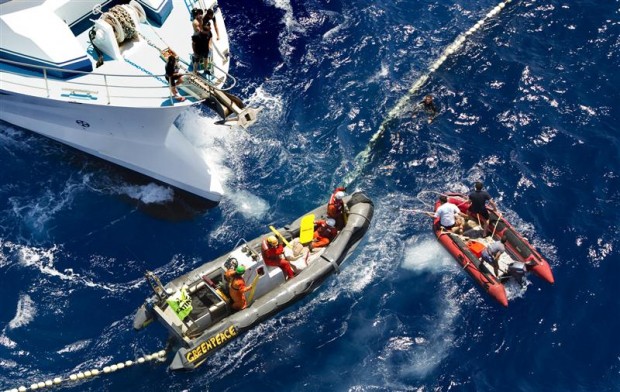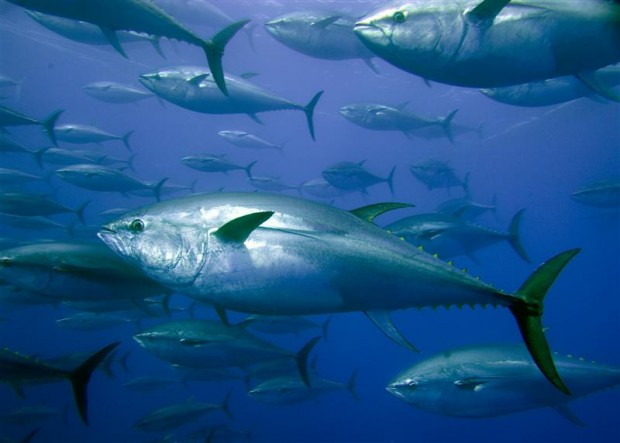Last Friday was the penguins' special day. Now this Friday is World Tuna day; and whilst the world's most popular fish might not be as cute as the waddling creatures, they are amazing wild species that are vital to the ocean ecosystem and deserve to have their story told.
 When I look at our collection of images, it becomes obvious that it's not only the tuna that are in trouble. Over-exploitation by large ships - some taking as much tuna in two days as whole countries can take in year - hurts other marine species too.Unsustainable fishing methods with FADs (Fish Aggregation Devices) create massive quantities of bycatch, as the pictures below of the whale shark and rainbow runners show.
When I look at our collection of images, it becomes obvious that it's not only the tuna that are in trouble. Over-exploitation by large ships - some taking as much tuna in two days as whole countries can take in year - hurts other marine species too.Unsustainable fishing methods with FADs (Fish Aggregation Devices) create massive quantities of bycatch, as the pictures below of the whale shark and rainbow runners show.
But it's not all doom and gloom for tuna! The lovely photo of the fishermen catching skipjack with pole and line illustrates a sustainable way of fishing and consumer awareness. Supported by people like Hugh Fearnley-Whittingstall, it shows supermarkets that people care what is in the tin.

Tuna transshipment on the high seas in the Indian Ocean between the Taiwan-registered Chin Horng No 3 and the Panama-registered reefer vessel Tuna Queen in 2013. © Jiri Rezac / Greenpeace

Greenpeace is on patrol in the Indian Ocean documenting a tuna transshipment between the Taiwanese longliner Yi Long No 202 and the Tuna Queen, registered in Panama in 2013. © Jiri Rezac / Greenpeace

Diver Joel Gonzaga of the the Philippine purse seiner 'Vergene' is at work using only a single air compressor hose to the surface, in and around a skipjack tuna purse seine net, in the international waters of high seas pocket No1 in 2012. © Alex Hofford / Greenpeace

Bycatch of Rainbow Runners is caught in a net of fishing trawler Yu Wen 101. Many of the fish die before being thrown back, Pacific Ocean, 2004. © Greenpeace / Roger Grace

A purse seine vessel catches a whale shark as bycatch in the Pacific. Whale sharks, being slow swimming filter feeding fish, act as natural aggregation devices for tuna in tropical oceans and are killed in unsustainable numbers in purse seine fisheries. 2007 © Greenpeace

A French purse seiner, Jean Marie Christian 7, rams a Greenpeace inflatable during a direct action. Activists from the Greenpeace ships Rainbow Warrior and the Arctic Sunrise launched high speed inflatable boats in an attempt to submerge one side of a purse seine fishing net to free the trapped bluefin tuna. 2010 © Paul Hilton / Greenpeace

Skipjack tuna is caught by pole-and-line off Flores, Indonesia. Tuna products are the second biggest Indonesian fishery product exports, contributing 13 percent of total export value. Japan, the United States, and European Union countries have been the main market for fresh and frozen tuna from Indonesia. 2011 © Paul Hilton / Greenpeace

A fisherman carries a yellowfin tuna to be weighed and sold at the fish port complex of General Santos in Mindanao. 2010 © John Javellana / Greenpeace

Yellowfin tuna is seen at an auction at Dong Gang wholesale fish market, Dong Gang, Kaohsiung. 2012 © Alex Hofford / Greenpeace

John Sauven (Executive Director Greenpeace Uk, l) and Hugh Fearnley-Whittingstall speaking at the Greenpeace Tuna League Table Launch event. 2011 © John Cobb / Greenpeace

Greenpeace activists dressed as 'Tuna Mascots' visit the Korean Embassy, seeking the country's support for tuna conservation at the upcoming global summit on Pacific Tuna Fisheries. 2012 © Pat Roque / Greenpeace

Oriental and Pacific tinned tuna being returned to the supermarket Tesco after Hugh Fearnley Whittingstall's programme "Fish Fight" aired on television. The tuna is caught using destructive and unsustainable methods and this is not shown on the tin. 2014 © John Cobb / Greenpeace

The Rainbow Warrior arrives in San Diego flying a "Ocean Safe Tuna Now" banner to call attention to the need for sustainable tuna fishing methods. 2013 © David McNew / Greenpeace



